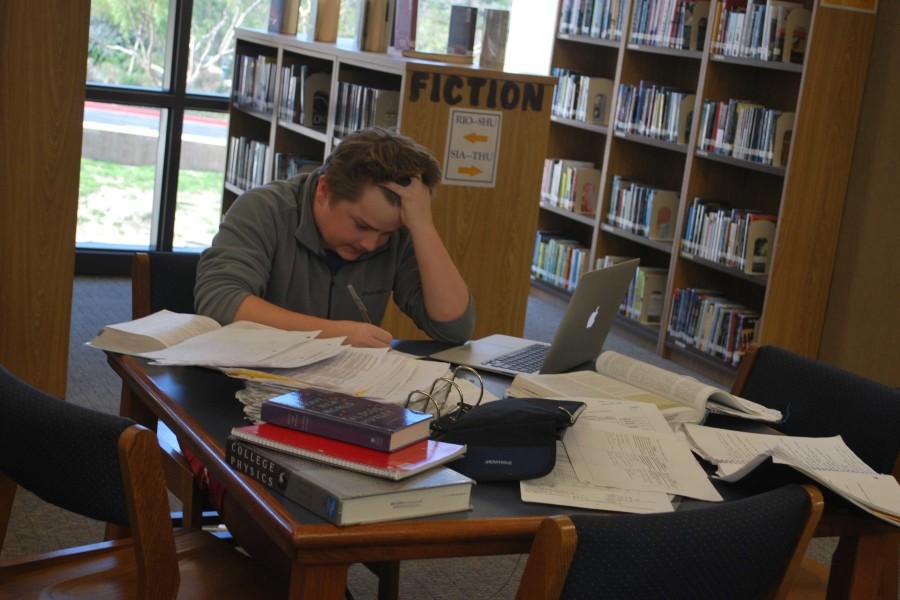Less Stress
STRESSED AND DEPRESSED: Ian Happy (10) when he’s not so happy with school. With all of his classes piling on him, Happy has nearly had it with the day. Happy is a perfect example of students who face the stress and pressure that school and society can provoke.
February 11, 2015
Stressed to depressed. A common transition in today’s society, especially in teenagers.
With the high expectations of today’s society, teenagers are left with a sense of fear for the future and of failing themselves or those close to them. Unfortunately, stress has become extremely common in young people under pressure.
If not dealt with properly, stress may lead to serious consequences.
Stress affects every part of the body; physically, mentally and emotionally. Side effects can include permanent damage to the brain, increased blood pressure, headaches, unexplained waves of emotion, and trouble sleeping. Effects differ with every person, based on how they handle stress or any other emotion.
Everyone has different ways of handling stress. Remedies may vary with each person but exercise, meditation, massages, and regulated rest may help prevent stress from arising.
“Because this is my most important year academically, I’ve found yoga really helps with my mood and stress level,” said Haley Fryer (11).
“When I’m stressed I eat,” said Monica Hibler (12).
But sometimes stress acts as a motivator to increase one’s efforts toward success.
“School leaves me tons stressed at the end of the day, sure, but I always keep moving forward,” said Taylor Davis (12).
Keeping up grades isn’t the only reason behind stress though. The social factor plays a gigantic part as well in the conversion from stressed to depressed.
Many students believe others think the worst of them, especially those genetically born with depression or any other mental disorder. This leaves them will an almost guaranteed sense of self-loathing. They see judgment wherever they go and feel they have no way to escape, which can lead to further and more drastic thoughts of pain and sorrow, possibly even suicide.
With the increase in expectations and use of social media, suicide amongst teens has risen greatly over the years. According to the American Academy of Child and Adolescent Psychiatry, suicide has become the third leading cause of death amongst those between the ages of fifteen and twenty-four.
Of course, not all cases of stress lead to suicide, but it is an unfortunate outcome.
Confidence itself comes in many forms and can be very hard to obtain. But despite any emotion writhing inside, friends and family should always be there for you and be willing to hear what you have to say.
Talking about one’s insecurities is an important way to overcome them. Keeping them bottled up inside only increases chances of a dangerous episode from occurring. Insecurities emerge when a person fails to achieve a certain status or level in society, either physically or academically.
In today’s society, there is an unrealistic idea of perfection, and people shouldn’t set their own physical expectations to those seen in magazines.
Individuals worry everyday about how they look, whether or not they passed a test, or what others think of them. This can spread and invoke large doses of stress and may eventually lead to severe cases of depression. Like dominoes, the consequences will continue to fall unless stopped.
Stress and depression should never be taken lightly and should be dealt with right away. If you or someone you know is experiencing thoughts of suicide, call the National Suicide Prevention line at 1-800-273-8255.
“You can call the line and they will assess the level of serverity and crisis. They talk to people and help them feel less desperate and less alone so that they are not actively suicidal. They also connect people with local resources and support. It is not counseling per se, more like crisis response. Once the crisis is resolved, they refer you to counseling.”



Michele • Feb 11, 2015 at 3:50 PM
Great article!